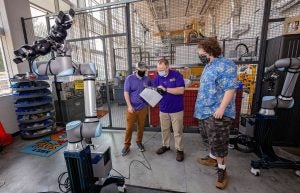CHANGING THE WORLD
New robots at ECU provide students training for the future
With the ease of a maestro conducting an orchestra, a new robot explores its working space in the Department of Technology Systems at East Carolina University.
Its arm moves seamlessly, rotating as needed without restrictions, providing a glimpse of the future for students and industry leaders.
“It’s changing the world,” teaching instructor Bill McClung said of the two new UR Model 10 robots. “These machines are going to change how people apply robots, and that’s why we want them here at East Carolina.”
McClung said what makes the robots so much better than older models is that they are collaborative, or cobots.
“They have the finesse to work with humans in close quarters without a danger to the humans,” McClung said. “They are easier to program, more capable and easier to implement than traditional robots.”
The robots are designed to move objects from one place to another. As an example, the robots could be programmed to pick up a product, place it into one of the milling machines in the high bay of the Science and Technology Building, pull it out when it’s done and place it in a new location before starting the process over again.
“We are developing an advanced manufacturing lab, and these robots are equipment that help drive advanced manufacturing initiatives,” McClung said.
McClung said the new robots are easier to set up than traditional robots and require about two weeks of training before students can program them to do simple tasks.
“It was less complicated than I thought it would be,” student Kevin Davis said. “The programming of it is really simplified with the UR robots. I had to take a little training to get the hang of it, but throughout the training, I could see where everything was coming from and you could work through it.”
He said the new robots offer an unique feature that older ones do not.
“It’s able to remember its position in the physical space of a particular area,” he said. “It knows where each part of its body is. If it senses any kind of resistance, it will stop.”
McClung said the new robots can reach farther and pick up more weight than older robots.

Teaching instructor Bill McClung, center, assists students Drew Thomas, left, and Kevin Davis in programming a robot in the Science and Technology Building.
“They are the latest technology as far as robots go,” he said. “Everything in industry is going to go this way, so all the manufacturers are developing collaborative robots, and pretty soon, any robot you buy is going to be a collaborative robot. It’s like comparing a car from the 1970s to a car today. They may be equivalently priced cars, but think about what you get in a car today that you didn’t get in a car in 1970. It was a feature to have air-conditioning in the 1970s. It was a feature to have power windows and power locks. Today, every car has those.”
It’s technology that will give ECU students an advantage after graduation.
“It’s encouraging to see what the industry is using and to be able to use that now before we graduate,” graduate student Drew Thomas said. “Having that experience is invaluable, and hopefully, it will put us in a good position to get a job once we graduate.”
McClung said the new robots could benefit regional industry as well.
“We’re going to be using them to help develop new solutions for industry. We can bring industrial partners in here so they can try things out with our robots to see how they work,” he said. “The price and horsepower on these robots are so good that even small mom-and-pop shops, small industries and small businesses could suddenly get into the robot business. As a university and a regional partner, we want to be able to go out in our region and tell them if they want to do robots, they can come over to ECU and we can show them how it works. We can help them.”
Eventually the robots could be tied into ECU’s distribution and logistics program and have cybersecurity applications for students as well.
“There are lots of opportunities,” McClung said. “We’re excited to have them.”
